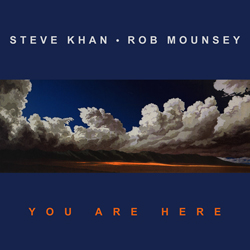Steve Khan's "Anhelante"
Lead sheet
On
both our CDs, Rob Mounsey and I had agreed that
we would each bring in a ballad to the project. On the
"LOCAL COLOR"(Denon) CD, Rob contributed "Mahana,"
and "The Blue Rose" was my entry. On our current release,
"YOU ARE HERE", my ballad represents, I think,
one of my favorite pieces of writing to date. "Anhelante"(which
I have translated from the Spanish dictionary to mean
"yearning" or "longing") is the fullest realization of
my studies of the voicing style of Clare Fischer.  His influence permeates this composition. Rob seemed to
be most fascinated by the fact that the tune moves in
and out of tempo. In general, on the CD, there is a significant
Latin and Afro-Cuban presence, it's in the 'attitude'
of the music and is physically supplied by the brilliant
performances of percussionist Marc Quiñones.
When "Anhelante" does go into tempo, it is done in the
style of a 'bolero' rhythm, with Marc supplying the necessary
patterns on congas, bongos, and timbales.
His influence permeates this composition. Rob seemed to
be most fascinated by the fact that the tune moves in
and out of tempo. In general, on the CD, there is a significant
Latin and Afro-Cuban presence, it's in the 'attitude'
of the music and is physically supplied by the brilliant
performances of percussionist Marc Quiñones.
When "Anhelante" does go into tempo, it is done in the
style of a 'bolero' rhythm, with Marc supplying the necessary
patterns on congas, bongos, and timbales.
Though I have enjoyed
many of Clare Fischer's recordings over the years, I was
greatly inspired to study his scores more closely upon
hearing his CD, "LEMBRANÇAS"(Concord Picante).
He performs on this CD with a '90s version of what would
have been a Fender Rhodes in another time. The sound is
especially beautiful and lends itself to a particular
voicing style where small clusters of notes seem 'hidden'
within the chord. It seems that this style does not always
translate well to the acoustic piano. Perhaps the best
examples of these kinds of voicings are found in the 'bolero'
sections: [A2] and [C]. Even though [A2]
can be described as a vamp over an Fm9(#7) and suggests
that one might improvise using the F-melodic minor scale,
if you look at bar 3 you can see that a C7(alt.) voicing
is hinted at which gives the feeling of a V7(alt.) resolving
to im7. The inclusion of this one chord gives the vamp
a very special hypnotic quality, and if you follow only
the top voice of each chord, it stands as a melody in
long tones on its own.
The composition also features
the usage of one particular voicing which employs two
major triads, one atop the other. The upper triad is usually
in the first inversion and the lower triad in the second
inversion. These appear in all the rubato sections: [A],
[B], [D], and the [Tag] or the coda.
You're looking at what is essentially the mini-score Rob
and I used to perform the piece. For those of you who
might never have seen this style of writing a lead sheet
for a 'free ballad,' I should explain a couple of notations.
In the rubato sections I essentially use the fermata to
indicate that in the space after the chord, the player
can improvise. In several places you will also see the
use of a wavy line(from left to right). I employ this
to indicate that, in these spaces, I may improvise something.
It is telling Rob to be alert and leave the space open.
Once the recording was completed I made some adjustments
to the written music to accommodate improvements we made
as the piece developed from the initial draft. No matter
how detailed my mini-score is, I can't say enough about
just how beautifully Rob consistently performed it, and
with a most beautiful electric piano sound of his own
creation. I really hope you enjoy listening to this piece
and exploring harmonies such as this on your own. If you are interested in reading some more about just how Rob and I came to work together like this, you won't want to miss the Khan/Mounsey Saga which hopefully explains everything.
Those of you who have visited this page before will notice that we have just added an alternate cover, which Rob created, featuring the artwork of Doug West, who had contributed the painting for "LOCAL COLOR." Of course, I thought it would be nice to have some continuity in our cover art, but here, we were at odds. So, the agreement we finally came to was that, IF we secured a domestic release in Japan, we would then use the cover you see here.
|

